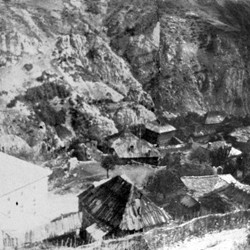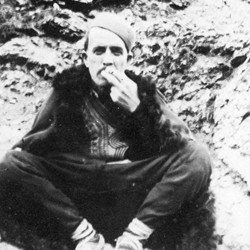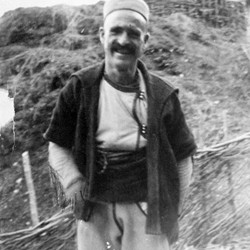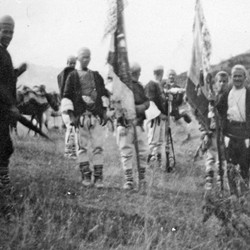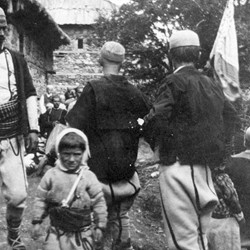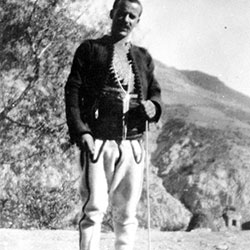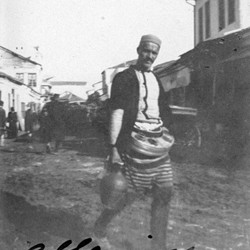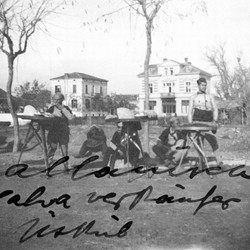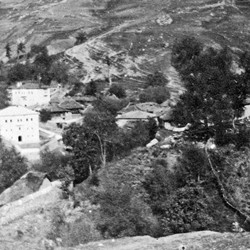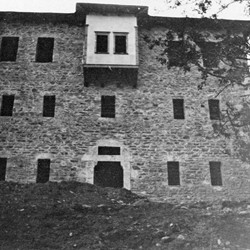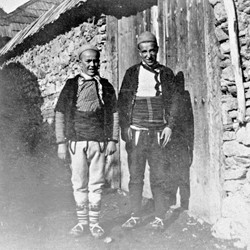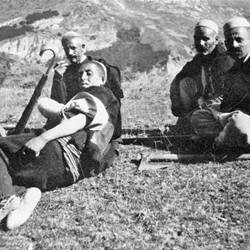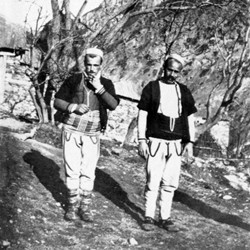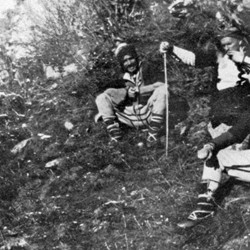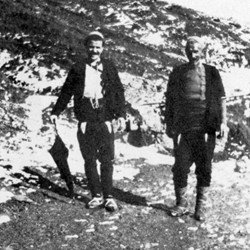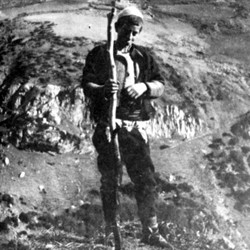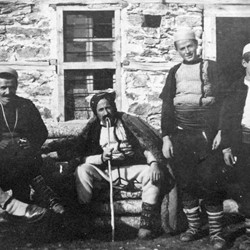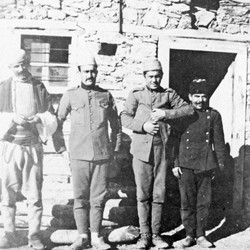| | Robert Elsie | AL Art | AL History | AL Language | AL Literature | AL Photography | Contact | |
Robert Elsie
Early Photography in Albania
BACK | AL Photography
The Photo Collection of Bajazid Doda
Deutsch | ShqipMacedonia 1907
Bajazid Elmaz Doda was born ca. 1888 in the mountain village of Shtirovica in Upper Reka (Reka e Epërme / Gorna Reka) region of western Macedonia. Like many young men from Reka, he left the mountains and emigrated to Romania in search of work. In Bucharest on 20 November 1906, he met the noted Hungarian scholar, Baron Franz Nopcsa (1877-1933), who hired the eighteen-year-old lad as his servant.
This relationship evolved into a love affair and a long-term domestic partnership. In his memoirs, published in German in 2001 under the title Reisen in den Balkan (Travels in the Balkans), Nopcsa describes his first meeting with his young lover, disguised as his private secretary:
"On 20 November 1906, in Bucharest, I met Bajazid Doda. Since that time, Bajazid has been with me and, since the death of Louis Draškovic, he has been the only person who has truly loved me and in whom I had full confidence, never doubting for a moment that he would misuse my trust. He of course had his failing, but I was more than willing to put up with them. The Serbs murdered Bajazid's father and brother in 1913 out of hatred for everything Austro- Hungarian, and in particular out of hatred for me, because I was active in Albania."
From Bucharest, Nopcsa and his young servant travelled to the Nopcsa family estate in Szacsal (Sacel) near Hatzeg in Transylvania and, several months later, on to London where Bajazid caught influenza. In mid November 1907, the two journeyed to Shkodra where Nopcsa had a house in 1907-1910 and from October 1913 onwards. They carried on over the mountains of Mirdita to Kalis where they were taken hostage by the notorious robber Mustafa Lita. After their release in Prizren, they travelled to Skopje and no doubt on to the upper Reka valley, as originally planned. They then returned to Shkodra in order to explore the territory of the Hoti and Gruda tribes.
In the years before and during the Balkan Wars, Nopcsa and his temperamental Albanian secretary travelled throughout northern Albanian, Kosova and Macedonia. In the autumn of 1913, Nopcsa reported:
"Once, when Nikol Gega and Bajazid, in a fit of sudden fury, seized their revolvers and were only prevented from killing one another by the intervention of Gjok Prenga and Mehmet Zeneli, I was able to arbitrate to the detriment of neither, and make peace between them so that they were eventually reconciled. Many Europeans were amazed at how I was able to keep all these very different characters together, who like all Albanians incline to envy and jealousy... From Shkodra, once I had put my household affairs in order, I set off for the mountains. My plan was firstly to climb the southern slopes of the northern Albanian Alps and then the area just west of the Prokletije, the Accursed Mountains. Due to malaria, however, I was obliged to abandon this part of my plan and limited myself to the upland parts of Kastrati which were easier to scale. Bajazid scaled Mount Veleçik, the Kunora e Keneshdolit and some other mountains in my place and took the photographs needed for the topographical maps of the northern Albanian Alps."
In the war years, 1915-1916, Nopcsa took his secretary with him while he was serving with Austro-Hungarian troops in Kosova. After the First World War, Bajazid Elmaz Doda and Franz Nopcsa lived mostly in Vienna, where the Hungarian scholar published several works of note, and enjoyed fame as a specialist not only in Albanian studies, but also in palaeontology and geology.
On 25 April 1933, Baron Nopcsa, who had long been suffering from depression, committed suicide by shooting himself in the mouth. Just before his death, he shot his faithful secretary and partner, Bajazid Doda. In a suicide note to the police, Nopcsa confirmed:
"The reason for my suicide is my nervous system which is at its end. The fact that I killed my long-term friend and secretary, Mr Bajazid Elmaz Doda, in his sleep, without him having an inkling as to what was going in, was because I did not want to leave him behind sick, in misery and in poverty because since he could have suffered too much. I wish to be cremated."
Bajazid Elmaz Doda is the author of the book Albanisches Bauerleben im oberen Rekatal bei Dibra (Makedonien), [Albanian Peasant Life in the Upper Reka Valley near Dibra (Macedonia)], that he completed as a typescript in Vienna in April 1914 and that was finally published in Vienna in 2007. The original typescript and the 2007 edition are accompanied by photographs taken, according to the author, by Doda himself. They are probably from the year 1907. The pictures are primarily of the author's native village of Shtirovica and surroundings, though there are also two photos of Skopje. This photo material is of particular historical value because the village in question has disappeared - nothing remained but a grassy meadow and a few piles of stones. Its native Albanian inhabitants were expelled from the Reka valley by Bulgarian troops in about 1916.
The book "Albanian Peasant Life in the Upper Reka Valley near Dibra (Macedonia)" contains a wide range of material and information on various fields and should prove useful for many subjects of research. It would also seem to be the first ethnological study ever written in German by an Albanian. Doda explains his objectives in a preface:
During the Turkish period, my homeland, the Upper Reka Valley, was isolated from the outside world due to a short- sighted policy aimed at propping up a barbaric regime. As a result of recent events, it has come under Serb rule, and it is now to be feared that the Muslim element in Upper Reka, in view of its traditional isolation, will vanish and leave no trace. The purpose of this book describing the life of the Muslims in the Upper Reka Valley is to counter this trend, to help my fellow Muslim villagers preserve their identity, and to create a lasting monument among the publications dealing with Albania. What Spiridion Gopcevic has to say about Reka in his notorious book on Macedonia (Makedonien und Alt-Serbien, 1889) is all tendentious lies, something which has been noted by other travellers before me.
I did not intend to write an academic treatise on ethnography or some serious dissertation, but simply to describe this part of the world as I experienced it myself on a daily basis.
When those who exterminated the Albanians in the region of Nish [Niš] have also wiped out my people, the simplest accurate description of their daily life will suffice to serve both as a permanent monument to their one-time existence and as an indictment to those who annihilated them.
The translation of the manuscript of this work was carried out by Dr Baron Nopcsa, and the illustrations derive from photographs I took myself.
We are grateful to the Photo Archives of the Austrian National Library (Bildarchiv der Österreichischen Nationalbibliothek) in Vienna for permission to present the Doda Collection for the first time, where it is preserved under the inventory numbers NB902060B to NB902076B.
Robert Elsie
TOP
